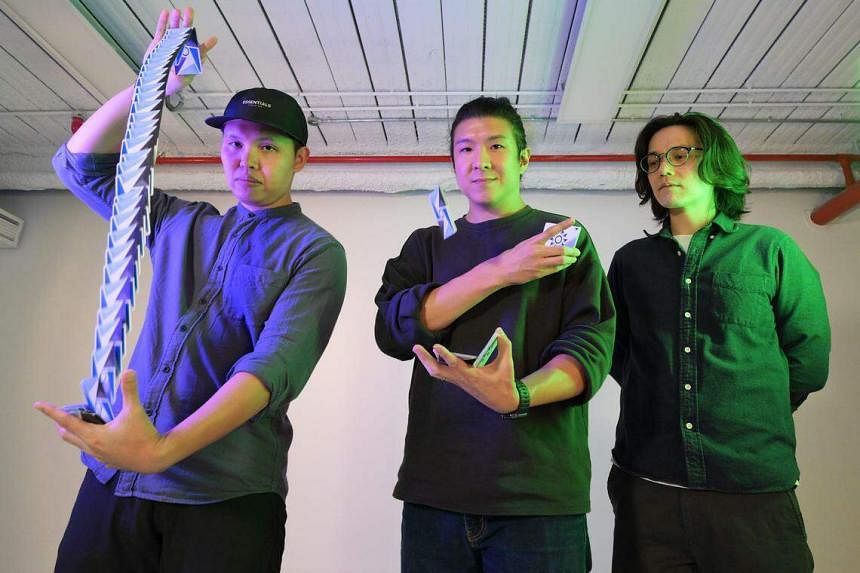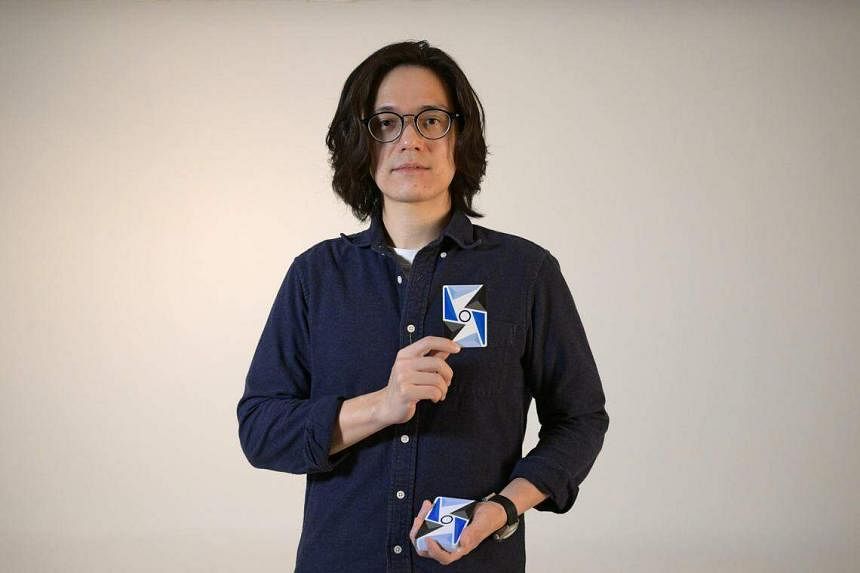SINGAPORE – Good friends Daren Yeow and Huron Low spent much of their adolescent years with a deck of playing cards in hand and met one recurrent phrase:
“Boy, cannot play cards here,” the staff at almost every cafe they visited would say to them before chasing them out, believing them to be teenage gamblers.
“The ironic thing about what we do is that if you put us at a poker table, we’re probably the worst players there,” Mr Yeow, 33, said.
Many in Singapore at the time did not know the two were honing the niche skill of cardistry – a form of performance art focused on manipulating playing cards. A portmanteau of “card” and “artistry”, cardistry was a subset of magic before evolving into its own genre.
Cardists – as the people who practise cardistry are called – use their hands to artistically manipulate playing cards into visually appealing cuts, displays, fans and sequences.
Mr Low, 35, a cardist of about 20 years along with Mr Yeow, said of his passion: “If magic is acting, then cardistry is dance.”
They met at an event while learning magic and picked up cardistry during this time.
Since those early days of cafe-hopping, the pair have gone on to become pioneers in the international cardist community.
In 2012, they and a friend, Mr Joshua Tan, founded Virtuoso – widely regarded in the cardistry community as the first cardistry company, not just in Singapore, but in the world.
Virtuoso produced the first deck of cards designed purely for cardistry and has continued to create and sell original cards since. It also offers video tutorials for cardists of all levels, though its customers are typically teenagers.
Mr Tan, now 38, is not a cardist – he designs the company’s cards.
Also known as The Virts, Mr Yeow and Mr Low have also shared a YouTube channel since 2007. Their polished videos showcasing elaborate cardistry routines have racked up over 21 million total views and garnered 167,000 subscribers.
Mr Yeow and Mr Low have invented around 30 original cardistry moves, and have been invited to places such as Italy, Berlin and New York to give talks and workshops. They were also featured in a Discovery Channel documentary in 2015.

Virtuoso’s products are sold in 77 countries. Its rare, early decks have been resold at online marketplaces, such as Ebay, for almost US$300 (S$406), at least 20 times their original price.
The brand’s card decks are much thinner than traditional playing cards and allow cardists to handle them with greater ease. The paper cards are specially coated with plastic, and have micro air pockets which let them spread smoothly in the hands, but also seal tight when compressed and thrown into the air.
The traditional black and red colours typically seen on playing cards are also replaced with more unconventional colours such as blue and orange. Moving away from designs with hearts, diamonds, clubs and spades also has another bonus: It helps push the products away from associations with gambling.
Early days
When they were in their late teens, the pair, who were also passionate about film-making, realised that videos were one avenue to practise cardistry professionally.
But it was only in 2010 that they came up with the idea of producing their own deck of cards, motivated by the lack of resources in the cardistry community.
Mr Yeow explained that traditional playing cards follow a “template” with very intricate designs which can appear blurry when used for card flourishing, diminishing the performance.
Traditional playing cards are meant to stand independent of the deck and typically feature magic-themed illustrations such as dragons and fire, Mr Tan said.
Virtuoso’s cards do away with visual clutter, instead opting for clean and minimalist geometric shapes that amplify cardistry movements.
Mr Tan, who has a keen interest and background in graphic design, was roped in as the company’s designer and co-founder after meeting Mr Low through his brother.

Back then, he was a fresh university graduate in search of a job and professional cardistry ventures were practically unheard of.
Asked what convinced him to take the leap of faith without being a cardist himself, Mr Tan replied: “It was amazing to see them perform and it’s not every day you get an opportunity to work with people who are literally the best in the world at what they do.
“If I could come up with something that looks great, and these guys could use it to perform at the level that they do, that would be pretty amazing, right?
“Playing cards are very common, but cardistry elevates something so simple and so everyday into something that’s so beautiful. When they perform, it’s really mesmerising.”
He added that playing cards are typically associated with vices like gambling, but cardistry’s ability to elevate them out of that realm into “something else all together” made the collaboration an exciting opportunity.
Struggling with others’ scepticism
While Virtuoso’s decks were a hit upon their launch and exceeded the minimum print quantity of 2,500 multiple times, Mr Yeow said when the founders were starting out, they struggled most with scepticism from others, particularly their parents.
Their parents worried about the economic viability of a career in the arts and entertainment, how they would succeed in a virtually undeveloped industry, and the possibility that their young sons were involved in gambling.
Even the magic industry – an already small community – had doubts that cardistry could be a profitable business as it was a “niche within a niche”, said Mr Low.
To top it all, Mr Yeow had just done badly in his O-level examinations while Mr Low had just failed his A-level examinations, when they firmed up their resolve to do cardistry full-time.
“The real challenge was telling my parents I wanted to start this business even though I’d just failed my O-levels…I love this thing, I’m good at it and when I think about something I would love to pursue for the rest of my life, it’d be this,” said Mr Yeow, adding that the bulk of their challenges lay in “getting people to believe in what we were doing”.
Mr Low echoed this sentiment: “The last thing you want to tell your mum is, ‘I failed my O-levels, but don’t worry my friend only failed his A-levels, so we’re going to do this.’”
He said that the likelihood of letting his parents down weighed heavily on his mind, adding that they had initially advised him to redirect his passion for cardistry into seemingly more practical channels.
Recounting his worries at the time, Mr Low said: “Am I gonna go from failing school and not getting a degree to failing at everything else as well?”
But their parents eventually saw how much cardistry meant to them and supported them by providing them funds to procure professional cameras, as well as allowances for the young entrepreneurs in the firm’s first two years, until it started turning a profit.
“We were very, very blessed. We didn’t have to juggle five jobs, we could just focus fully on what we were doing,” Mr Yeow said.
Mr Tan added that they were able to minimise starting costs by basing the business online and manufacturing each deck of cards on a pre-order basis, such that production was fully funded by customers.
To this day, Virtuoso has been the three men’s first and only full-time jobs.
“I like to tell people that my brother’s a fighter pilot, my sister’s a doctor, and I’m the middle child that shuffles cards for a living,” Mr Low said half in jest.
All three are also happily married, with wives who have stood by them and never once pressured them to take a more conventional route.
Cardistry, they said, has taught them everything about perseverance and making the impossible possible. These lessons remained with them even after Virtuoso took off and they struggled to stay true to their integrity as artists.
Virtuoso’s founders said designing things that can withstand the test of time is a crucial aspect of their brand’s ethos. While their competitors might release a new deck every few weeks, Virtuoso does so only once or twice a year.
But this becomes difficult in an age where markets crave a constant flow of new content and products, making it tempting to prioritise quantity over quality.
Mr Low said: “For us, it’s about doing our best to stay true to what we believe is the right thing to release, something that we are proud of, even if it’s at the expense of potentially putting out a lot more stuff (and making more money).”
What keeps them going
Undergraduate Khit Goh, 24, chanced upon Virtuoso while trying his hand at cardistry in 2013.
He said: “They were one of the most popular practitioners internationally then, if not the most popular, and it was really inspiring to see as a young Singaporean.
“I remember having so much fun learning their signature tricks from their (video) tutorials. Everyone wanted their decks and you could definitely see how their designs influenced the scene as many people tried to replicate it.”
When he started out in cardistry, Mr Goh said he managed to snag one of Virtuoso’s earlier sold-out decks for $50 – around five times its original price – from online marketplace Carousell.
But he found it too precious to practise with and instead used cheaper decks until he was confident he had mastered a trick.
“Then, I’d do it with their deck and feel like a cardistry god. They really nailed the perfect geometry in their card face design because it really makes all your tricks look infinitely better,” he said, adding that his interest in cardistry lasted about two years.
Now studying graphics programming at the Digipen Institute of Technology, Mr Goh recounted a time when he took his Virtuoso deck to school and destroyed the cards when he left them in his pocket while playing football with friends.
“It was a moment of childhood trauma,” he joked.
Mr Low said: “We have people who have grown up with us, people who share that they can tie down every single deck release to some milestone in their life.”
Mr Goh concurs. Whenever Virtuoso’s content pops up on his social media feed, he still gets hit by a wave of nostalgia, reflecting on childhood memories he has almost forgotten.
“I consider Virtuoso to be a national treasure,” he said.
From impressions of vice to Virtuoso
Virtuoso’s success is not just about getting people to shed their impressions of cardistry as a vice, Mr Yeow said. It is also about the activity gaining recognition as a legitimate craft and enabling children and teenagers today to pursue cardistry without being judged.
“Trying to convince my parents that cardistry wasn’t this crazy thing helped me to be mindful that we are not just selling to kids, we are also selling to their parents,” he explained.
“And if their parents feel it’s safe, naturally they will have no issue supporting whatever it is their kid is passionate about.
“The hope is that slowly over time, if kids were to sit at the cafes we used to today, they wouldn’t hear the staff tell them: No gambling.”

